 Tìm kiếm
Tìm kiếm
Chương 1 Luật Sĩ quan Quân đội nhân dân Việt Nam 1999: Những quy định chung
| Số hiệu: | 16/1999/QH10 | Loại văn bản: | Luật |
| Nơi ban hành: | Quốc hội | Người ký: | Nông Đức Mạnh |
| Ngày ban hành: | 21/12/1999 | Ngày hiệu lực: | 01/04/2000 |
| Ngày công báo: | 15/02/2000 | Số công báo: | Số 6 |
| Lĩnh vực: | Bộ máy hành chính | Tình trạng: | Còn hiệu lực |
TÓM TẮT VĂN BẢN
Văn bản tiếng việt
Văn bản tiếng anh
Sĩ quan là lực lượng nòng cốt của quân đội và là thành phần chủ yếu trong đội ngũ cán bộ quân đội, đảm nhiệm các chức vụ lãnh đạo, chỉ huy, quản lý hoặc trực tiếp thực hiện một số nhiệm vụ khác, bảo đảm cho quân đội sẵn sàng chiến đấu và hoàn thành mọi nhiệm vụ được giao.
Đội ngũ sĩ quan đặt dưới sự lãnh đạo tuyệt đối, trực tiếp về mọi mặt của Đảng Cộng sản Việt Nam, sự thống lĩnh của Chủ tịch nước, sự quản lý thống nhất của Chính phủ và sự chỉ huy, quản lý trực tiếp của Bộ trưởng Bộ Quốc phòng.
Công dân nước Cộng hoà xã hội chủ nghĩa Việt Nam có đủ tiêu chuẩn về chính trị, phẩm chất đạo đức, trình độ học vấn, sức khỏe và tuổi đời; có nguyện vọng và khả năng hoạt động trong lĩnh vực quân sự thì có thể được tuyển chọn đào tạo sĩ quan.
Những người sau đây được tuyển chọn bổ sung cho đội ngũ sĩ quan tại ngũ:
1. Hạ sĩ quan, binh sĩ tốt nghiệp các trường đào tạo sĩ quan hoặc các trường đại học ngoài quân đội;
2. Hạ sĩ quan, binh sĩ hoàn thành tốt nhiệm vụ chiến đấu;
3. Quân nhân chuyên nghiệp và công chức quốc phòng tại ngũ tốt nghiệp đại học trở lên đã được đào tạo, bồi dưỡng chương trình quân sự theo quy định của Bộ trưởng Bộ Quốc phòng;
4. Cán bộ, công chức ngoài quân đội và những người tốt nghiệp đại học trở lên được điều động vào phục vụ trong quân đội đã được đào tạo, bồi dưỡng chương trình quân sự theo quy định của Bộ trưởng Bộ Quốc phòng;
5. Sĩ quan dự bị.
1. Sĩ quan có quyền và nghĩa vụ công dân theo quy định của Hiến pháp và pháp luật nước Cộng hoà xã hội chủ nghĩa Việt Nam; có quyền, nghĩa vụ và trách nhiệm theo quy định của Luật này.
2. Sĩ quan được Nhà nước bảo đảm về chính sách, chế độ ưu đãi phù hợp với tính chất hoạt động đặc thù quân sự.
Trong Luật này, các từ ngữ sau đây được hiểu như sau:
1. Ngạch sĩ quan tại ngũ là ngạch gồm những sĩ quan thuộc lực lượng thường trực đang công tác trong quân đội hoặc đang được biệt phái.
2. Sĩ quan biệt phái là sĩ quan tại ngũ được cử đến công tác ở cơ quan, tổ chức ngoài quân đội.
3. Ngạch sĩ quan dự bị là ngạch gồm những sĩ quan thuộc lực lượng dự bị động viên được đăng ký, quản lý, huấn luyện để sẵn sàng huy động vào phục vụ tại ngũ.
4. Sĩ quan dự bị hạng một, sĩ quan dự bị hạng hai là sĩ quan thuộc ngạch dự bị, được phân hạng theo hạn tuổi dự bị hạng một, dự bị hạng hai quy định tại khoản 1 Điều 13 của Luật này.
5. Sĩ quan chỉ huy, tham mưu là sĩ quan đảm nhiệm công tác tác chiến, huấn luyện và xây dựng lực lượng về quân sự.
6. Sĩ quan chính trị là sĩ quan đảm nhiệm công tác đảng, công tác chính trị.
7. Sĩ quan hậu cần là sĩ quan đảm nhiệm công tác bảo đảm về vật chất cho sinh hoạt, huấn luyện và tác chiến của quân đội.
8. Sĩ quan kỹ thuật là sĩ quan đảm nhiệm công tác bảo đảm về kỹ thuật vũ khí, trang thiết bị.
9. Sĩ quan chuyên môn khác là sĩ quan đảm nhiệm công tác trong các ngành không thuộc các nhóm ngành sĩ quan quy định tại các khoản 5, 6, 7 và 8 Điều này.
10. Phong cấp bậc quân hàm sĩ quan là quyết định trao cấp bậc quân hàm cho người trở thành sĩ quan.
11. Thăng cấp bậc quân hàm sĩ quan là quyết định đề bạt sĩ quan lên cấp bậc quân hàm cao hơn.
12. Giáng cấp bậc quân hàm sĩ quan là quyết định hạ cấp bậc quân hàm hiện tại của sĩ quan xuống cấp bậc quân hàm thấp hơn.
13. Tước quân hàm sĩ quan là quyết định huỷ bỏ quân hàm sĩ quan của quân nhân.
14. Sĩ quan thôi phục vụ tại ngũ là sĩ quan chuyển ra ngoài quân đội.
15. Chuyển ngạch sĩ quan là chuyển sĩ quan từ ngạch sĩ quan tại ngũ sang ngạch sĩ quan dự bị hoặc ngược lại.
16. Chuyển hạng sĩ quan dự bị là chuyển sĩ quan dự bị từ hạng một sang hạng hai.
17. Giải ngạch sĩ quan dự bị là chuyển ra khỏi ngạch sĩ quan dự bị.
Sĩ quan chia thành hai ngạch: sĩ quan tại ngũ và sĩ quan dự bị.
Hệ thống cấp bậc quân hàm của sĩ quan gồm ba cấp, mười hai bậc:
1. Cấp Uý có bốn bậc:
Thiếu uý;
Trung uý;
Thượng uý;
Đại uý.
2. Cấp Tá có bốn bậc:
Thiếu tá;
Trung tá;
Thượng tá;
Đại tá.
3. Cấp Tướng có bốn bậc:
Thiếu tướng, Chuẩn Đô đốc Hải quân;
Trung tướng, Phó Đô đốc Hải quân;
Thượng tướng, Đô đốc Hải quân;
Đại tướng.
1. Chức vụ cơ bản của sĩ quan gồm có:
Trung đội trưởng;
Đại đội trưởng;
Tiểu đoàn trưởng;
Trung đoàn trưởng, Huyện đội trưởng;
Lữ đoàn trưởng;
Sư đoàn trưởng, Tỉnh đội trưởng;
Tư lệnh Quân đoàn;
Tư lệnh Quân khu, Tư lệnh Quân chủng;
Chủ nhiệm Tổng cục;
Tổng Tham mưu trưởng, Chủ nhiệm Tổng cục Chính trị;
Bộ trưởng Bộ Quốc phòng.
2. Các chức vụ thuộc Bộ đội Biên phòng, binh chủng, cơ quan, nhà trường và các lĩnh vực khác tương đương với các chức vụ quy định tại khoản 1 Điều này và các chức vụ còn lại do cấp có thẩm quyền quy định.
1. Tiêu chuẩn chung:
a) Có bản lĩnh chính trị vững vàng, tuyệt đối trung thành với Tổ quốc và nhân dân, với Đảng Cộng sản Việt Nam và Nhà nước Cộng hoà xã hội chủ nghĩa Việt Nam; có tinh thần cảnh giác cách mạng cao, sẵn sàng chiến đấu, hy sinh, hoàn hành tốt mọi nhiệm vụ được giao;
b) Có phẩm chất đạo đức cách mạng; cần kiệm liêm chính, chí công vô tư; gương mẫu chấp hành đường lối, chủ trương của Đảng, chính sách, pháp luật của Nhà nước; phát huy dân chủ, giữ nghiêm kỷ luật quân đội; tôn trọng và đoàn kết với nhân dân, với đồng đội; được quần chúng tín nhiệm;
c) Có trình độ chính trị, khoa học quân sự và khả năng vận dụng sáng tạọ chủ nghĩa Mác - Lê nin, tư tưởng Hồ Chí Minh, đường lối, quan điểm, chủ trương của Đảng và Nhà nước vào nhiệm vụ xây dựng nền quốc phòng toàn dân, xây dựng quân đội nhân dân; có kiến thức về văn hoá, kinh tế, xã hội, pháp luật và các lĩnh vực khác; có năng lực hoạt động thực tiễn đáp ứng yêu cầu nhiệm vụ được giao; tốt nghiệp chương trình đào tạo theo quy định đối với từng chức vụ;
d) Có lý lịch rõ ràng, tuổi đời và sức khoẻ phù hợp với chức vụ, cấp bậc quân hàm mà sĩ quan đảm nhiệm.
2. Tiêu chuẩn cụ thể đối với từng chức vụ của sĩ quan do cấp có thẩm quyền quy định.
Hạn tuổi cao nhất của sĩ quan tại ngũ và sĩ quan dự bị được quy định như sau:
Cấp Uý: tại ngũ 44, dự bị hạng một 46, dự bị hạng hai 48;
Thiếu tá: tại ngũ 46, dự bị hạng một 49, dự bị hạng hai 52;
Trung tá: tại ngũ 49, dự bị hạng một 52, dự bị hạng hai 55;
Thượng tá: tại ngũ 52, dự bị hạng một 55, dự bị hạng hai 58;
Đại tá: tại ngũ 55, dự bị hạng một 58, dự bị hạng hai 60;
Cấp Tướng: tại ngũ 60, dự bị hạng một 63, dự bị hạng hai 65.
2. Theo chức vụ chỉ huy đơn vị:
Trung đội trưởng 30;
Đại đội trưởng 35;
Tiểu đoàn trưởng 40;
Trung đoàn trưởng 45;
Lữ đoàn trưởng 48;
Sư đoàn trưởng 50;
Tư lệnh Quân đoàn 55;
Tư lệnh Quân khu, Tư lệnh Quân chủng 60.
Hạn tuổi cao nhất của sĩ quan giữ chức vụ lãnh đạo, chỉ huy trong các đơn vị kỹ thuật, chuyên môn, quân sự địa phương và dự bị động viên có thể cao hơn hạn tuổi cao nhất của chức vụ tương ứng quy định tại khoản này nhưng không quá 5 tuổi.
3. Khi quân đội có nhu cầu, sĩ quan có đủ phẩm chất, năng lực, sức khoẻ và tự nguyện thì có thể được kéo dài thời hạn phục vụ tại ngũ đến hết hạn tuổi dự bị hạng một; sĩ quan làm công tác nghiên cứu khoa học và giảng dạy ở nhà trường có thể được kéo dài đến hết hạn tuổi dự bị hạng hai; trường hợp đặc biệt có thể được kéo dài trên hạn tuổi dự bị hạng hai.
Trong phạm vi chức năng, nhiệm vụ, quyền hạn của mình, các cơ quan, tổ chức, đơn vị vũ trang nhân dân và mọi công dân có trách nhiệm xây dựng đội ngũ sĩ quan.
Article 1.- Officers of the Vietnam People’s Army
The officers of the Vietnam People’s Army (hereafter called officers) are cadres of the Communist Party of Vietnam and the State of the Socialist Republic of Vietnam, operating in the military domains and bestowed the rank of company officer, field officer or general officer by the State.
The military uniforms, shoulder straps and insignia of officers are stipulated by the Government.
Article 2.- Position, function of officers
The officers constitute the core of the army and the principal element of the contingent of military officials, who undertake the leading, commanding or managing posts or directly perform a number of other tasks, ensuring that the army is ready for combat and the fulfillment of any assigned tasks.
Article 3.- Leading, commanding and managing officers
The contingent of officers is placed under the absolute, direct and comprehensive leadership of the Communist Party of Vietnam, the supreme command of the State President, the unified management of the Government and the direct command and management of the Minister of Defense.
Article 4.- Recruitment conditions for training of officers
Citizens of the Socialist Republic of Vietnam who meet all criteria on politics, virtues, educational levels, health and age, wish and have capability to operate in the military domain may be recruited for training to be officers.
Article 5.- Supplementary sources of active officers
The following people shall be recruited to supplement the contingent of active officers:
1. Non-commissioned officers, cadets graduating from officers’ training schools or non-military universities;
2. Non-commissioned officers and men who have well fulfilled their combat tasks;
3. Career military personnel and military employees on active service, who have university or higher degrees and have been trained, fostered in military programs under the stipulations of the Minister of Defense.
4. Non-military officials and employees and persons with university or higher degrees, mobilized for service in the army and trained, fostered in the military programs under the stipulations of the Minister of Defense;
5. Reserve officers.
Article 6.- Rights, obligations and responsibilities of officers
1. Officers have the rights and obligations of citizens under the Constitution and laws of the Socialist Republic of Vietnam; have the rights, obligations and responsibilities as prescribed in this Law.
2. Officers are guaranteed by the State with the preferential policies and regimes suitable to the nature of the particular military activities.
Article 7.- Interpretation of terms
In this Law, the following terms are construed as follows:
1. Active officers are the officers of the standing force who are on active service in the army or sent on dispatch.
2. Dispatched officers are active officers who are sent to work in non-military agencies or organizations.
3. Reserve officers are the officers of the reserve force, who are registered, managed and trained to be ready to be mobilized into the army.
4. Class-one reserve officers and class-two reserve officers are the reserve officers, classified according to ages for the class-one and class-two reserve as provided for in Clause 1, Article 13 of this Law.
5. Commanding and staff officers are the officers who undertake the tasks of combat operation, training and building of the military forces.
6. Political officers are the officers who undertake the Party work and political work.
7. Logistic officers are the officers who undertake the tasks of material supply for daily life, training and combat activities of the army.
8. Technical officers are the officers who undertake the technical work regarding weapons and equipment.
9. Other specialized officers are the officers who undertake the work in branches other than those performed by officers’ groups defined in Clauses 5, 6, 7 and 8 of this Article.
10. Officer’s rank bestowal means the decision to grant the military rank and grade to a to be-officer.
11. Officer’s rank promotion means the decision to promote an officer from a lower rank to a higher rank.
12. Officer’s rank demotion means the decision to demote an officer from a higher rank to a lower rank.
13. To strip off officer’s rank means the decision to deprive an army man of the officer’s rank.
14. Demobilized officers are the officers who have been transferred outside the army.
15. To change the officer’s status means to transfer an officer from the active status to the reserve status or vice versa.
16. To change the class of reserve officer means to transfer a reserve officer from class one to class two.
17. Discharge from the status of reserve officer means the transfer from the reserve officers’ status.
Article 8.- Statuses of officers
The officers are divided into two statuses: The active officers and the reserve officers.
Article 9.- Branch groups of officers
The officers cover the following branch groups:
1. The commanding, staff officers;
2. The political officers;
3. The logistic officers;
4. The technical officers;
5. Other specialized officers.
Article 10.- Officers’ ranks and grades system
The officers’ ranks and grades system comprises three ranks and twelve grades:
1. The company officer’s rank includes four grades
Second lieutenant;
Lieutenant;
Senior lieutenant;
Captain.
2. The field officer’s rank includes four grades:
Major;
Lieutenant colonel;
Senior lieutenant colonel;
Colonel.
3. The general rank include four grades:
Major general, naval rear-admiral;
Lieutenant general, naval vice-admiral;
Senior lieutenant general, naval admiral;
General.
Article 11.- Posts of officers
1. Officers’ fundamental posts include:
Platoon leader;
Company commander;
Battalion commander;
Regiment commander, district military commander;
Brigade commander;
Division commander, provincial military commander;
Army corps commander;
Military Region commander; army service commander;
General Department director;
Chief of the General Staff, director of the Political General Department;
The Minister of Defense.
2. The posts of the Border Guard, services, agencies, schools and other fields similar to the posts defined in Clause 1 of this Article and the remaining posts shall be stipulated by the competent authorities.
Article 12.- Criteria of officers
1. General criteria:
a) Being politically steadfast, absolutely loyal to the Fatherland and people, the Communist Party of Vietnam and the State of the Socialist Republic of Vietnam; having the spirit of high revolutionary vigilance, being ready to fight, make sacrifice and fulfill all assigned tasks;
b) Having revolutionary virtues; being industrious, thrifty, incorruptible, upright, devoted and impartial; being exemplary in observing the lines and under-takings of the Party as well as policies and laws of the State; promoting democracy, strictly maintaining the army disciplines; respect and unite with people, with comrades-in arms; being trusted by the mass;
c) Having the political and military qualifications and the capability to creatively apply Marxism-Leninism, the Ho Chi Minh thoughts, the Party’s and State’s lines, viewpoints and policies to the task of building the entire-people defense as well as the people’s army; having knowledge about the cultural, economic, social, legal and other matters; having the capability to carry out practical activities, meeting the requirements of the assigned tasks; having graduated from the training programs prescribed for each post;
d) Having clear life story, ages and health suited to the officers’ posts and ranks.
2. The specific criteria for each officer’s post are stipulated by the competent authorities.
Article 13.- Service ages of officers
The maximum age limits for active officers and reserve officers are stipulated as follows:
1. According to officers’ ranks
The company rank: Active: 44, class-one reserve: 46, class-two reserve: 48;
Major: Active: 46, class-one reserve: 49, class-two reserve: 52;
Lieutenant colonel: Active: 49, class-one reserve: 52, class-two reserve: 55;
Senior lieutenant colonel: Active: 52, class-one reserve: 55, class-two reserve: 58;
Colonel: Active: 55, class-one reserve: 58, class-two reserve: 60
The general rank: Active: 60, class-one reserve: 63, class-two reserve: 65.
2. According to commanding posts:
Platoon leader 30
Company commander 35
Battalion commander 40
Regiment commander 45
Brigade commander 48
Division commander 50
Army corps commander 55
Military Zone commander, service commander 60
The maximum age limits for leading and commanding officers of technical, professional, regional army and reserve units may be higher than those of the corresponding posts stipulated in this Clause, but must not be 5 years older.
3. When the army has the demand, officers with full qualifications, capability, good health and voluntariness may extend their service in the army to the age limits for class-one reserve officers; officers engaged in scientific research and teaching at schools may extend their service to the age limits for class-two reserve officers; for special cases, the officers’ service may extend beyond the age limits for class-two reserve officers.
Article 14.- Responsibility to build the officers’ contingent
Within the scope of their respective functions, tasks and powers, agencies, organizations, people’s armed forces units and all citizens have the responsibility to build the contingent of officers.
Cập nhật
Bài viết liên quan
Tuổi nghỉ hưu của quân nhân chuyên nghiệp mới nhất 2025 là bao nhiêu?
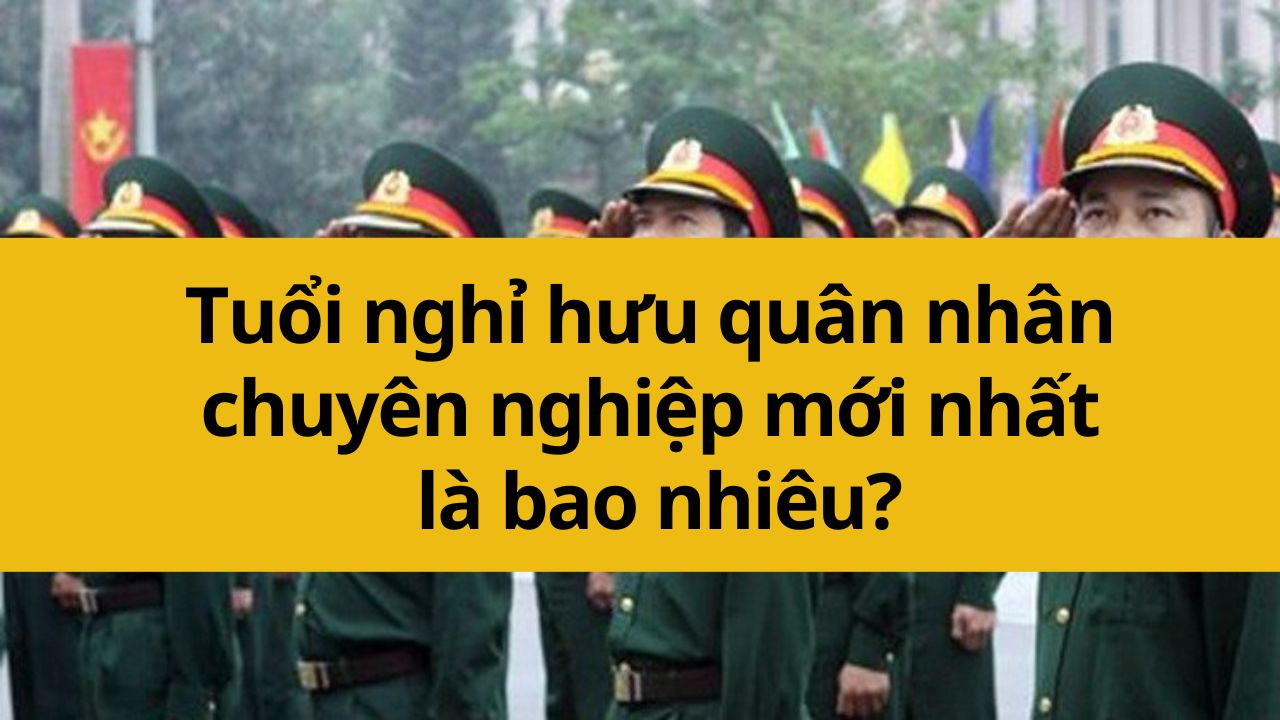
Tuổi nghỉ hưu của quân nhân chuyên nghiệp mới nhất 2025 là bao nhiêu?
Tuổi nghỉ hưu của quân nhân chuyên nghiệp là một trong những vấn đề quan trọng trong việc quản lý nhân sự trong quân đội. Mỗi năm, các quy định về độ tuổi nghỉ hưu có thể được điều chỉnh để phù hợp với yêu cầu công tác và sự phát triển của lực lượng vũ trang. Trong năm 2025, độ tuổi nghỉ hưu của quân nhân chuyên nghiệp đã được quy định cụ thể, nhằm đảm bảo sự ổn định và hiệu quả trong công tác tổ chức, điều động nhân sự. Bài viết này sẽ cập nhật thông tin về tuổi nghỉ hưu của quân nhân chuyên nghiệp theo quy định mới nhất. 31/12/2024Sĩ quan quân đội khi nghỉ hưu thì được hưởng những quyền lợi gì mới nhất 2025?
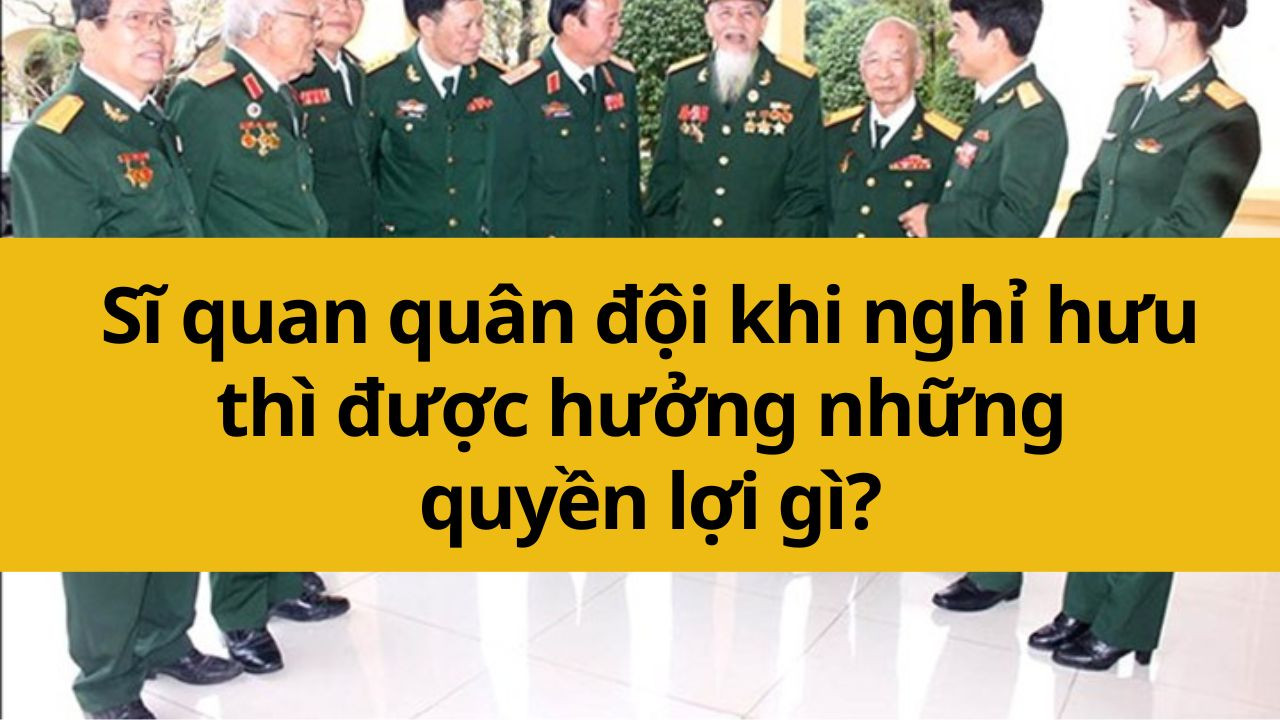
Sĩ quan quân đội khi nghỉ hưu thì được hưởng những quyền lợi gì mới nhất 2025?
Việc nghỉ hưu của sĩ quan quân đội không chỉ đánh dấu một chặng đường dài phục vụ tổ quốc mà còn gắn liền với các quyền lợi và chế độ đặc biệt, nhằm đảm bảo đời sống ổn định cho họ sau khi rời quân ngũ. Trong năm 2025, các quy định về quyền lợi của sĩ quan nghỉ hưu có những điểm mới quan trọng, bao gồm chế độ lương hưu, trợ cấp một lần, cũng như các quyền lợi về khám chữa bệnh, nhà ở, và các phúc lợi khác. Bài viết này sẽ cập nhật các quyền lợi mà sĩ quan quân đội được hưởng khi nghỉ hưu theo các quy định mới nhất, nhằm giúp hiểu rõ hơn về chế độ chính sách dành cho họ. 31/12/2024Tuổi nghỉ hưu của sĩ quan quân đội mới nhất 2025
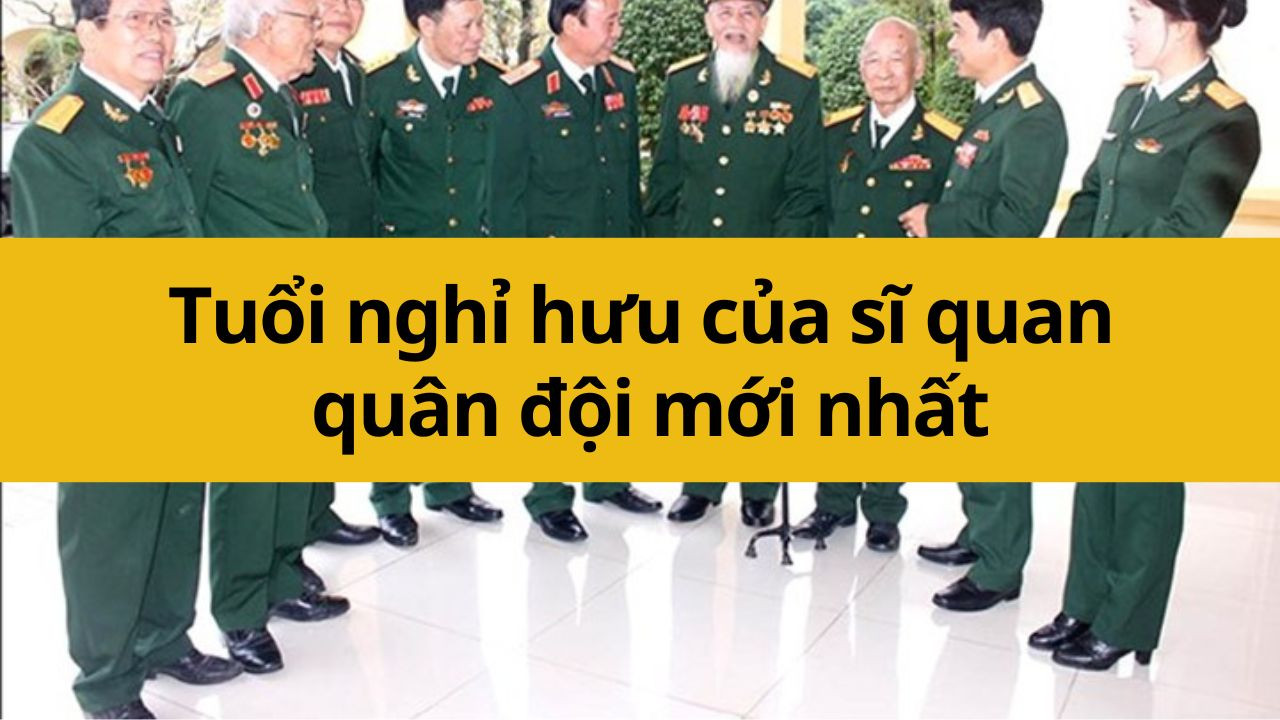
Tuổi nghỉ hưu của sĩ quan quân đội mới nhất 2025
Trong quân đội, việc xác định tuổi nghỉ hưu của sĩ quan là một vấn đề quan trọng, ảnh hưởng trực tiếp đến công tác tổ chức và điều động cán bộ. Mỗi năm, các quy định về tuổi nghỉ hưu có thể được điều chỉnh nhằm đáp ứng yêu cầu phát triển của lực lượng vũ trang và tình hình thực tế của đất nước. Bài viết này sẽ cập nhật thông tin mới nhất về tuổi nghỉ hưu của sĩ quan quân đội, giúp hiểu rõ hơn về các quy định và chính sách liên quan. 31/12/2024Từ 01/7/2024 mức lương Trung úy quân đội nhân dân là bao nhiêu khi mức lương cơ sở thay đổi?
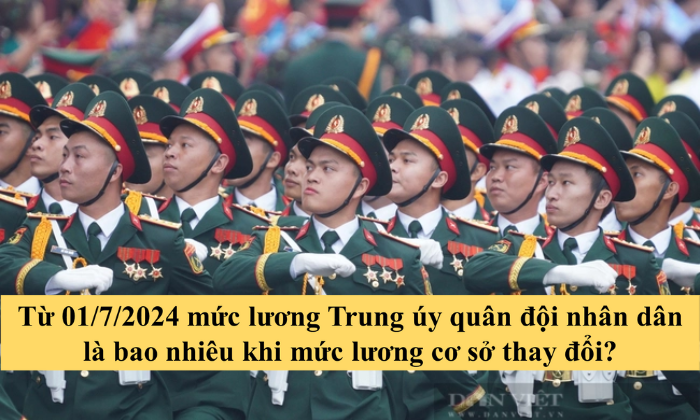
Từ 01/7/2024 mức lương Trung úy quân đội nhân dân là bao nhiêu khi mức lương cơ sở thay đổi?
Từ ngày 01/7/2024, mức lương cơ sở sẽ có sự điều chỉnh, kéo theo những thay đổi về thu nhập của cán bộ, công chức, viên chức, và lực lượng vũ trang, bao gồm cả Quân đội nhân dân Việt Nam. Đối với Trung úy - một trong những cấp bậc sĩ quan quan trọng trong quân đội, câu hỏi đặt ra là mức lương của họ sẽ thay đổi như thế nào khi áp dụng mức lương cơ sở mới? Bài viết này sẽ cung cấp thông tin chi tiết về mức lương của Trung úy Quân đội nhân dân sau khi mức lương cơ sở chính thức điều chỉnh vào tháng 7/2024. 09/11/2024Binh sĩ dự bị hạng hai bao gồm những đối tượng nào? Huấn luyện binh sĩ dự bị hạng hai phải đạt những yêu cầu gì?
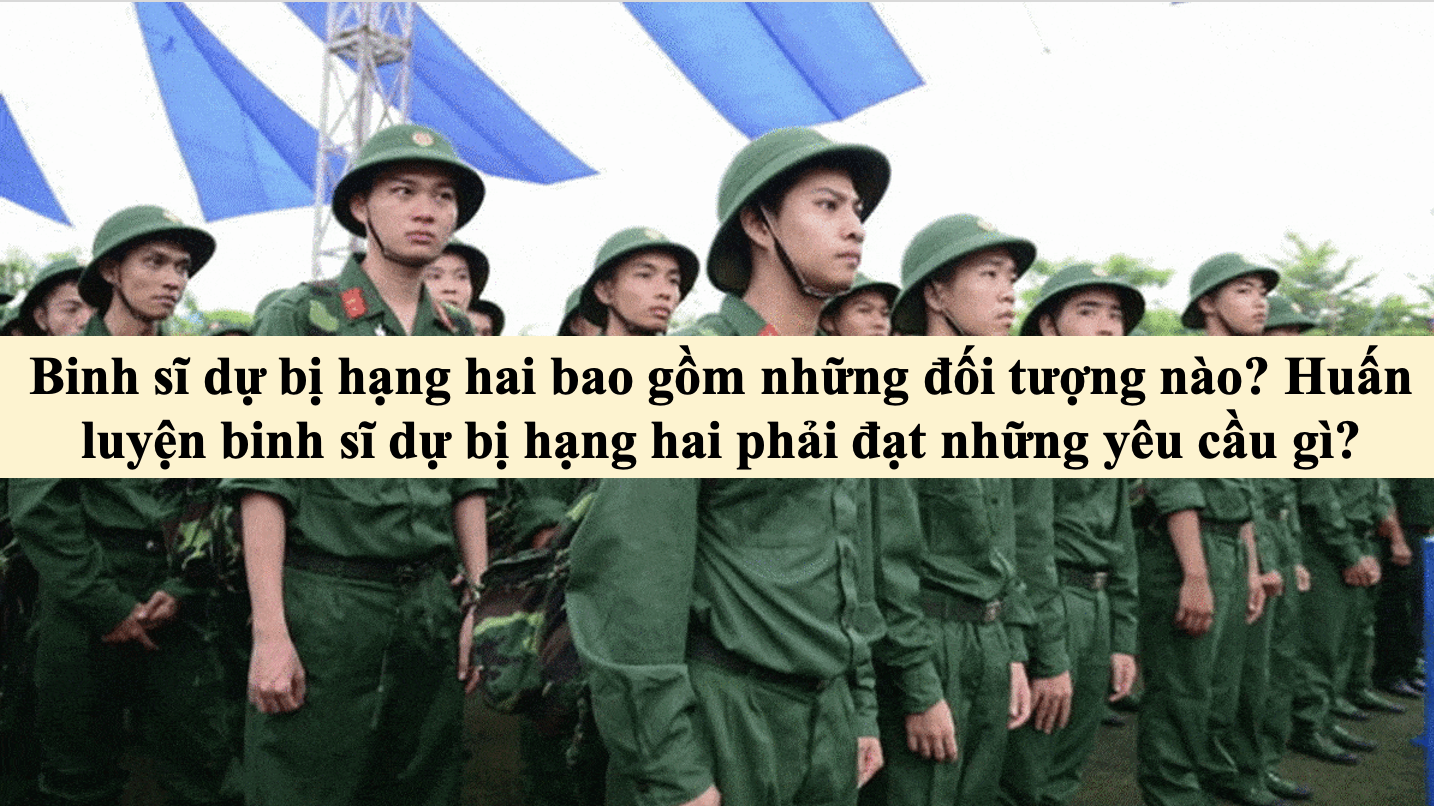

 Luật Sĩ quan Quân đội nhân dân Việt Nam 1999 (Bản Word)
Luật Sĩ quan Quân đội nhân dân Việt Nam 1999 (Bản Word)